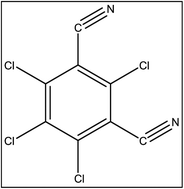Determination of chlorothalonil in difficult-to-analyse vegetable matrices using various multiresidue methods
Abstract
The molecular characteristics of

* Corresponding authors
a European Union Reference Laboratory for Pesticide Residues in Fruits and Vegetables, Pesticide Residue Research Group, University of Almería, Almería, Spain
b Faculty of Chemistry and Pharmaceutical Science, University of Chile, 233 Santiago, Chile
c VWA - Food and Consumer Product Safety Authority, Chemistry Laboratory, Pesticides and Mycotoxins R&D Group, National Reference Laboratory (NRL) for Pesticides in Food, Amsterdam, The Netherlands
d
Department of Hydrogeology and Analytical Chemistry, University of Almeria, La Cañada de San Urbano, Almería, Spain
E-mail:
amadeo@ual.es
Fax: +34 950015483
Tel: +34 950015034
The molecular characteristics of

 Please wait while we load your content...
Something went wrong. Try again?
Please wait while we load your content...
Something went wrong. Try again?
N. Belmonte Valles, M. Retamal, M. A. Martínez-Uroz, M. Mezcua, A. R. Fernández-Alba and A. de Kok, Analyst, 2012, 137, 2513 DOI: 10.1039/C2AN15916C
To request permission to reproduce material from this article, please go to the Copyright Clearance Center request page.
If you are an author contributing to an RSC publication, you do not need to request permission provided correct acknowledgement is given.
If you are the author of this article, you do not need to request permission to reproduce figures and diagrams provided correct acknowledgement is given. If you want to reproduce the whole article in a third-party publication (excluding your thesis/dissertation for which permission is not required) please go to the Copyright Clearance Center request page.
Read more about how to correctly acknowledge RSC content.
 Fetching data from CrossRef.
Fetching data from CrossRef.
This may take some time to load.
Loading related content
